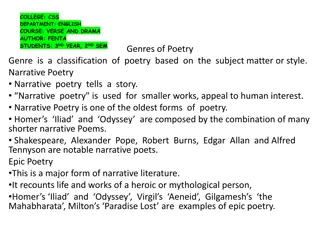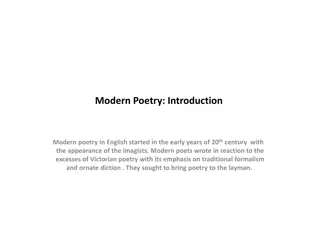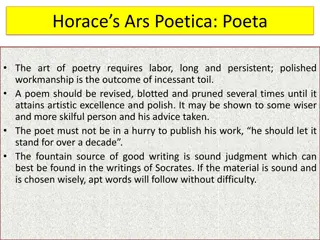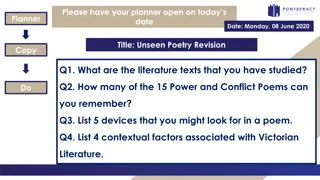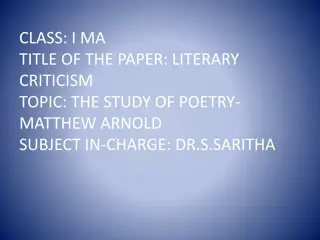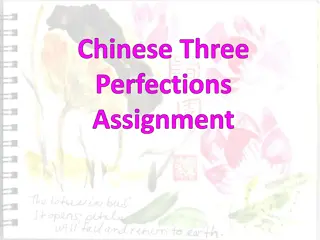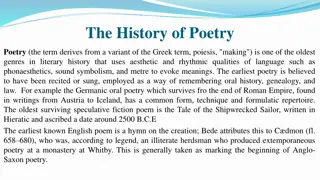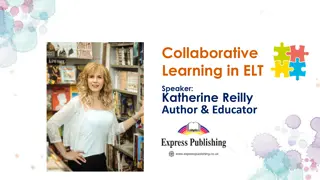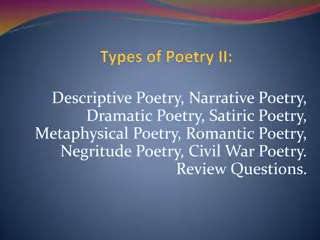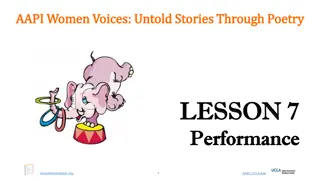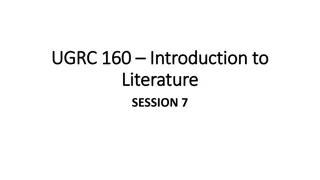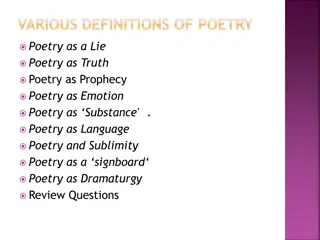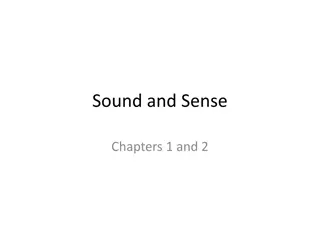Engaging Students with Poetry: A Collaborative Approach
Enrich your students' poetic experience through collaborative poetry appreciation activities. Begin by reading poems aloud, encourage multiple readings, prompt students to share their thoughts, and focus on enjoyment and specific elements during discussions. Inspire a love for poetry in your classroom!
Download Presentation

Please find below an Image/Link to download the presentation.
The content on the website is provided AS IS for your information and personal use only. It may not be sold, licensed, or shared on other websites without obtaining consent from the author.If you encounter any issues during the download, it is possible that the publisher has removed the file from their server.
You are allowed to download the files provided on this website for personal or commercial use, subject to the condition that they are used lawfully. All files are the property of their respective owners.
The content on the website is provided AS IS for your information and personal use only. It may not be sold, licensed, or shared on other websites without obtaining consent from the author.
E N D
Presentation Transcript
Fall In Love With Poems http://edsitement.neh.gov/lesson_index.asp http://www.teachingstylesonline.com http://www.teachingstylesonline.com
Collaborative Poetry Appreciation When children hear, write, and recite poetry, they understand more deeply the qualities of verse the importance of sound, compactness, internal integrity, imagination and line. Working collaboratively on poetry provides a safe structure for student creativity. http://www.teachingstylesonline.com
How to Begin the Poetic Experience Begin the unit by reading poems aloud to the class, one or more per day for a few days. When you read a poem for the first time, students should simply listen. If desired, use a motivator a read aloud, a picture, an experience to establish an anticipatory set. If you want them to have copies of the poem give it to them after the first reading and the brief discussion that follows. http://www.teachingstylesonline.com
Read Twice or Thrice Read each poem at least twice. In classes with strong volunteer readers, encourage students to read small sections of the piece to create a second reading (or third, if the poem is brief and a second reading by you is most appropriate). Different voices will bring something different to each reading. http://www.teachingstylesonline.com
Ask What Struck You After the first reading, ask students to tell what they noticed about the poem. What word or lines "jumped out" at them? All answers are correct; students are simply telling what happened to them as they listened to the poem. When appropriate, students can be asked to hypothesize why particular elements were memorable. Look for teachable moments here, but be brief and to the point. http://www.teachingstylesonline.com
What and What not to Focus Keep enjoyment of the poem itself the top priority. Mention figures of speech and other terminologies if you think that makes it easy to discuss the poems. When you read a second time ask the students to listen for specific elements. For example, if someone had pointed to a funny line, ask the students to listen for other lines they think are funny. http://www.teachingstylesonline.com
Read and Write a Poem Level One http://www.teachingstylesonline.com
Read Some Nursery Rhymes Read some nursery rhymes children are familiar with. Read a second or third time pausing for children to give you the rhyming words. Now read aloud only the rhyming words. Mix up the rhyming words and ask the children to match. Ask the children to give you other rhyming words for the one they find in the nursery rhyme. http://www.teachingstylesonline.com
Syllable Clap Begin by telling students that while some words rhyme, all words have one or more beats, depending on how many word parts they contain. Demonstrate how to clap out the beats, or syllables, in your first name. Clap your name out a second time, but this time ask students to count the number of times you clap. Tell students that the number of claps they counted is the number of beats, or syllables, in your name. Invite students to join you in clapping out the beats in each of their first names. Have children use rhythm instruments or body parts to beat out the syllables. http://www.teachingstylesonline.com
Catch a Little Rhyme Eve Merriam Once upon a time I caught a little rhyme I set it on the floor but it ran right out the door I chased it on my bicycle but it melted to an icicle I scooped it up in my hat but it turned into a cat http://www.teachingstylesonline.com
I caught it by the tail but it stretched into a whale I followed it in a boat but it changed into a goat When I fed it tin and paper it became a tall skyscraper Then it grew into a kite and flew far out of sight... http://www.teachingstylesonline.com
Word Family Rhyme Charts Copy the poem onto a piece of chart paper. Have students to circle each set of rhyming words with contrasting colours. Use a separate piece of chart paper to write each pair of rhyming words. Have students use markers to underline the word endings that rhyme in each pair. Guide students to notice that sometimes word endings that rhyme are spelled the same and other times they are spelled differently. Encourage the discovery that word endings that look different sometimes sound the same. http://www.teachingstylesonline.com
More Work with Rhymes Repeat this activity with other poems and stories that rhyme. As you discover more rhyming words, add them to the list of words that share the same word ending sound. If you wish, you may use a separate piece of chart paper for each family of word endings. Ask them to find nonsense rhyming words and use a different colour marker to write them. Display the word charts around the classroom. Use the lists of rhyming words you generate to help students write their own rhyming poems. http://www.teachingstylesonline.com
Read and Write a Poem Level Two http://www.teachingstylesonline.com
Be Glad Your Nose is on Your Face by Jack Prelutsky Be glad your nose is on your face, not pasted on some other place, for if it were where it is not, you might dislike your nose a lot. Imagine if your precious nose were sandwiched in between your toes, that clearly would not be a treat, for you'd be forced to smell your feet. http://www.teachingstylesonline.com
Your nose would be a source of dread were it attached atop your head, it soon would drive you to despair, forever tickled by your hair. Within your ear, your nose would be an absolute catastrophe, for when you were obliged to sneeze, your brain would rattle from the breeze. Your nose, instead, through thick and thin, remains between your eyes and chin, not pasted on some other place-- be glad your nose is on your face! http://www.teachingstylesonline.com
Activities Show a picture of some animals and their "noses." http://www.teachingstylesonline.com
Antennae In insects, the sense of smell is located chiefly in the antennae. http://www.teachingstylesonline.com
Amphibians Most amphibians (the group that includes frogs, toads and salamanders) sense smell using an organ inside their mouths. http://www.teachingstylesonline.com
Class Discussion Ask the students if anyone among them has ever banged his/her nose against something. Where else could our noses be located to avoid such accidents? As you read the poem, make sure to put humorous emphasis on the last line of each of the middle stanzas to demonstrate how each caps its verse. For example, show the class through your reading how unpleasant it would be to "be forced to smell your feet." http://www.teachingstylesonline.com
Work in Groups Work in groups of 3 and decide at least 3 activities you can ask the students to do. Keep in mind the age and level of the students you teach while planning the activities. Think of a project work that you can give to the students related to nose , smell , etc. http://www.teachingstylesonline.com
Writing Poetry Work with the handout. http://edsitement.neh.gov/lesson_images/lesson301/all_together_now.pdf Ask the whole class to work together. Collect the individual lines from students, put them in order randomly or intentionally and read the poem aloud as a whole. http://www.teachingstylesonline.com
Individual and Collaborative Writing For the whole class you say: "Write a poetry line that includes a color followed by the word 'as' and a comparison For the individual you say: "Write a poem in which almost every line includes a color followed by the word 'as' and a comparison. Locate the poem in a familiar place." http://www.teachingstylesonline.com
Choral Readings for Poems As your students continue to hear and write poetry throughout the year, give them opportunities to participate in recitations by the whole class, small groups or individuals. Ask them to read poems specially suited for choral reading. Ask them to read the poems written by them. http://www.teachingstylesonline.com
Read and Write a Poem Level Three http://www.teachingstylesonline.com
Emily Dickinson A bird came down the walk: He did not know I saw; He bit an angle-worm in halves And ate the fellow, raw. And then he drank a dew From a convenient grass, And then hopped sidewise to the wall To let a beetle pass. http://www.teachingstylesonline.com
He glanced with rapid eyes That hurried all abroad,-- They looked like frightened beads, I thought; He stirred his velvet head Like one in danger; cautious, I offered him a crumb, And he unrolled his feathers And rowed him softer home Than oars divide the ocean, Too silver for a seam, Or butterflies, off banks of noon, Leap, splashless, as they swim. http://www.teachingstylesonline.com
Introduction Introduce the lesson by telling students that today they will read a poem by Emily Dickinson, who lived in Massachusetts in the 1800s and wrote thousands of poems. Together as a class, read "A Bird came down the Walk " chorally. The students should recognize that there is a consistent rhythm (or pattern of beats), like in a song or nursery rhyme. You may want to have your students count out the syllables (or beats) with you. http://www.teachingstylesonline.com
Short Measure The first two lines have 6 syllables, the third line 8 syllables, and the fourth line 6 syllables. Poets call this pattern "short measure" because there are so few beats in each line. Dickinson doesn't adhere strictly to the rules. The fourth and fifth stanzas have additional or sometimes one too few syllables in a few lines. Many hymns are in short measure. With your students, read or listen to a hymn. You will find some hymns at http://www.ipl.org/ http://www.teachingstylesonline.com
Image and Metaphor Read the poem aloud again. Ask the students: What is this poem about? Be sure they understand that Dickinson is describing the physical qualities of a bird and its behavior-hopping, eating, flying, and so on. Show them paintings of birds, ask them to watch birds and think of the birds' shape, feathers, and features (eyes or beak, for example.) They can consider Qs such as; What would the bird feel like to touch? How would you describe this movement of the birds? How would you describe the sound they make? http://www.teachingstylesonline.com
Cluster Web Give them the cluster web handout. Ask the students to write "bird" in the center circle and to fill in the circles around it with the words they would use to describe a bird. Then they should fill in the circles attached to those words with the next words that come to mind. http://www.teachingstylesonline.com
Example feather light bird air http://www.teachingstylesonline.com
Second Reading Now, read the poem again with your students and ask them how Dickinson describes a bird. Does Dickinson describe some of the same qualities they saw in the images and found through the brainstorming activity? Ask your students to think about how Dickinson uses words to describe the bird. http://www.teachingstylesonline.com
Introduce Simile and Metaphor Emily Dickinson compares two seemingly unlike things. "He glanced with rapid eyes / That hurried The eyes are treated like a creature, able to run around. Can you picture the movement of the bird's eyes? How does this image add to your experience of the line? "They looked like frightened Beads" The eyes are compared to "beads." What do beads look like? Why might Dickinson compare the bird's eyes to beads? These "beads" are then given a human characteristic the quality of being frightened. Can eyes be frightened? Does this mean the bird is frightened? http://www.teachingstylesonline.com
"And he unrolled his feathers / And rowed him softer home" Here Dickinson describes the motion of a bird spreading its wings, but now the wings become oars. Can you visualize the act of rowing? Does this motion make you think of flying? Dickinson compares the sky to the sea. What similarities are there between the two? Is flying through the sky a "softer" motion than rowing through the water? In what way? "Butterflies Leap, plashless as they swim" In this line, the bird is now a butterfly, and the butterflies become fish or dolphins jumping into the sea. Might flying be like swimming through the air? Why might butterflies be "plashless" (or splashless)? Do you make a splash when you leap through the air? http://www.teachingstylesonline.com
Classroom Activities Now, to reinforce these ideas (and have some fun), have your students act out the poem together as a class. Begin with the first line: what would a bird look like as it "came down the Walk"? What is the birds' stance, attitude, or movement? Continue to the second and third lines . http://www.teachingstylesonline.com
Write a Poem Give them the write a poem handout. Have them observe a living thing: a squirrel, a beetle, ants, etc just preferably not a bird. As they watch their object, have them fill out the handout. Be sure they note how their animal or insect moves and how it reacts to its environment. As they're working, give each student another copy of the Web Cluster handout. The second part of the worksheet asks them to make a web cluster for their new object. http://www.teachingstylesonline.com
Third Reading Now, gather everyone together back in your classroom. Reread the Dickinson poem as a class and review its meter. Here you should make students aware of the poem's rhyming scheme: ABCB. Ask the students to write a 2 stanza (or 8 line) poem for their animal using 2 metaphors and the same meter and rhyming scheme as in Dickinson's poem. They should use their completed handout and web cluster to guide them. Encourage the students to help one another count out syllables and find rhyming words. Have the students share their poems with the class. http://www.teachingstylesonline.com
Assessment Ask students to submit a portfolio of their work from this lesson, including their two web clusters, Write a Poem! handout, and completed poem. Assess them based on the rubric below, granting point values as preferred. 1. Student participated fully in all activities. 2. Student contributed to class discussion. 3. Student demonstrated an understanding of rhythm and meter. 4. Web clusters show connections between objects/ideas. http://www.teachingstylesonline.com
Assessment 5. Write a Poem! handout shows careful observation of an animal/insect. 6. Write a Poem! handout demonstrates an understanding of "metaphor." 7. Story displays a synthesis of lessons learned. 8. Poem uses 2 metaphors and appropriate rhythm and rhyme. http://www.teachingstylesonline.com
Read and Write Poems Level Four http://www.teachingstylesonline.com
Limericks Read aloud the limerick. Read it again silently and identify the main features. There once was a fellow named Maun With a broad grin he acted like a clown With his blown up nose And his funny pose He became the laughing stock of the town. http://www.teachingstylesonline.com
Limericks 1st, 2nd and last lines rhyme. There once was a fellow named Maun With a broad grin he acted like a clown With his blown up nose And his funny pose He became the laughing stock of the town. 3rd and 4th lines rhyme. And the rhythm is da DUM da da DUM da da DUM da DUM da da DUM da da DUM da DUM da da DUM da DUM da da DUM da DUM da da DUM da da DUM http://www.teachingstylesonline.com
How to write a Limerick Think of a name: Ram, Lal, Tim, John, etc. List all the words that rhyme with that name. Example: Name: Rhyming words: Lal, call, tall, mall, fall, all, ball, etc. Write the second line using one of the rhyming words. Create a funny incident with the last line. Complete the third and fourth line of the funny incident. Example: http://www.teachingstylesonline.com
This is one of the possibilities. There once was a fellow named Lal, He wanted very badly to grow tall He hung from the gate To win over his fate Got a six inch bump hitting the wall. (He has added 6 inches to himself but has not grown taller in the way he expected.) http://www.teachingstylesonline.com
Read and Write Poems Level Five http://www.teachingstylesonline.com
Read some Haiku Poems Ask the students to recognize the main features: Very short: just three lines usually fewer than twenty syllables long. Descriptive: most haiku focus sharply on a detail of nature or everyday life. Personal: most haiku express a reaction to or reflection on what is described. Divided into two parts: as they read haiku aloud, students should find that each includes a turning point, often marked by a dash or colon, where the poet shifts from description to reflection, or shifts from close-up to a broader perspective. http://www.teachingstylesonline.com
Rules of Haiku Form: Traditional Japanese haiku have seventeen syllables divided into three lines 5, 7, 5, respectively. Structure: Haiku divide into two parts, with a break coming after the first or second line, so that the poem seems to make two separate statements that are related in some unexpected or indirect way. http://www.teachingstylesonline.com
Rules of Haiku Language: Haiku should include what Japanese poets call a kigo -- a word that gives the reader a clue to the season being described. The kigo can be the name of a season (autumn, winter) or a subtler clue, such as a reference to the harvest or new fallen snow. Subject: Haiku present a snapshot of everyday experience, revealing an unsuspected significance in a detail of nature or human life. Haiku poets write for a popular audience and give their audience a new way to look at things they have probably overlooked in the past. http://www.teachingstylesonline.com
Haiku Warm-up Brainstorm a glossary of words, e.g. related to season: robin, crocus, Final Four for spring; heatwave, fireworks, grasshopper for summer; jack-o-lantern, harvest, kickoff for autumn; icicle, hibernate, holly for winter For each season, have students choose an occurrence that might be the subject of a haiku and brainstorm descriptive language that would help a reader visualize that scene. List them on the chalk board. http://www.teachingstylesonline.com

 undefined
undefined




